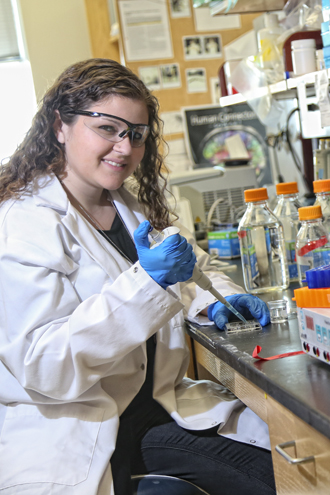Brandeis Inside Out: Dahlia Kushinsky '17
Kushinsky explains what makes Brandeis the perfect place to study science.

Dahlia Kushinsky ’17 came to Brandeis to major in neuroscience. What she did not expect was that she’d wind up working in the lab of one of the most respected neuroscientists in the country. And all it took was an email.
Kushinsky attended high school in Stoughton, Massachusetts. She took a psychology class in her senior year, the first third of which focused on neuroscience. “I thought this stuff is so cool,” she says. She chose Brandeis because “it’s a really well-known neuroscience department. If you tell someone in the neurosciences you went to Brandeis, they know it’s a good program.”
A few weeks after school started, Kushinsky emailed professor Eve Marder ’69, asking if she could work in her lab. Through her research on neural circuits, Marder, the Victor and Gwendolyn Beinfield Professor of Neuroscience, has transformed our understanding of how the brain adapts to changing circumstances. She recently was one of 14 scientists designing President Obama’s $100 million effort to solve the mysteries of the brain.
Kushinsky interviewed for a job in Marder’s lab and was hired. Her first year she washed equipment, prepared saline solutions and helped out wherever she was needed. It wasn’t glamorous work, but she saw how a major research lab functioned. “When I was a freshman I figured why do I care?” Kushinsky says. “But now that I’m actually using these skills I see how very important it is that you know how to do things correctly.”
|
Kushinsky's experiment. An electrode records the beating |
Kushinsky, the Debra A. Gravallese '79 Women in Science Scholar, says she also benefited by working side-by-side with the graduate and postgraduate students in Marder’s lab. "I’m studying with top PhD students in neuroscience which kind of puts me at the top also,” she says. “It’s very, very cool.”
This year, as a junior, Kushinsky has been doing her own research. Marder’s lab works with crustaceans because their nervous system is simple and easy to research. Kushinsky is studying the nerve cells inside the hearts of Jonah crabs. Typically, scientists study these neurons outside the animals in a petri dish. By inserting a wire into the body, Kushinsky examines the crab’s heart while it is still alive. She believes the in vitro and in vivo results might be different and interesting for understanding the heart’s function.
Kushinsky has also taken advantage of Brandeis’ combined BS/MS program in neuroscience. This will give her a leg up when she applies to graduate schools, she says. “Neuroscience is a very competitive field. Everyone is super interested in it,” she says. “It’s good to be ahead.”
Categories: Science and Technology, Student Life





